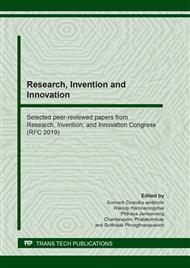p.237
p.245
p.253
p.261
p.268
p.276
p.286
p.294
p.303
Jute Fiber Reinforced Thermoplastic Composites Fabricated by Direct Fiber Feeding Injection Molding (DFFIM) Process
Abstract:
In this research, jute fiber reinforced polypropylene and poly (lactic acid) composites were fabricated, respectively by Direct Fiber Feeding Injection molding (DFFIM) process. Jute spun yarns were directly fed into the barrel of molding process in order to eliminate the fiber breakage during extrusion compounding process. Mechanical properties of both composites were investigated by tensile testing and morphological properties were characterized by scanning electron microscopy (SEM). For jute reinforced polypropylene (PP) composites, tensile strength of composite decreased but modulus increased, compared with neat PP. The using maleic anhydride grafted polypropylene (MaPP) can improve interfacial bonding between jute fiber and PP matrix as observed by SEM, which resulted in the increasing of tensile strength. Therefore, in the case of jute/PLA composites, jute fibers surface treated with sodium hydroxide (NaOH) and silane coupling agent to improve interfacial adhesion. The tensile strength of untreated-jute/PLA composites are not different with PLA matrix but tensile modulus of untreated composites are higher than PLA matrix. In addition it is found that the tensile properties of NaOH-treated jute/PLA and NaOH+Silane-treated jute/PLA composites were improved, compared with untreated composites.
Info:
Periodical:
Pages:
268-275
Citation:
Online since:
August 2020
Authors:
Price:
Сopyright:
© 2020 Trans Tech Publications Ltd. All Rights Reserved
Share:
Citation:


